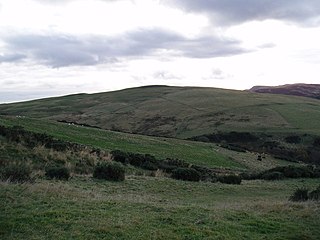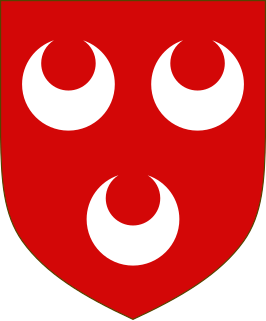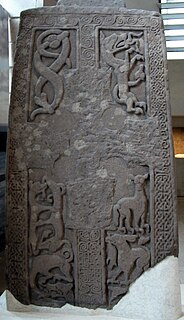History
The earliest history of the general area demonstrates that Pictish peoples inhabited the area. For example, discovery of the Eassie Stone in this region indicates sophisticated Pictish carvers who embraced Christianity about the year 600 AD. [2]
The lands were given to Sir William Olifard (8th chief) [3] in 1317 by Robert the Bruce. Robert the Bruce's daughter, Elizabeth, married Sir William Olifard's son, Sir Walter Olifaunt, [4] on whom the Newtyle estate was reconfirmed by her brother, David II by a charter dated 1364. The castle was built in 1575, [5] commissioned by Laurence, fourth Lord Oliphant (1527–1593). [6] Hatton Castle is unusual in that it contains a scale and platt staircase incorporated into its original construction. Such a feature was normally only included in larger constructions. The 4th Lord Oliphant also considerably extended another of his many castles, Kellie Castle in Fife, which bears many similarities.
A variety of people lived in Hatton Castle after the Oliphants, including at least one bishop. It is recorded by Marian McNeill, [7] quoting A. Hislop, Book of Scottish Anecdote, that the old Scots custom of 'enforced hospitality', to extract information from travellers, was demonstrated at Hatton Castle: "The Lords Oliphant used to keep a cannon pointed to the road near by their old castle, so as to compel the wayfarers to come in and be regaled". A cannon is still there today. Hatton was the home of the Masters of Oliphant rather than their fathers, who resided primarily at Aberdalgie and Dupplin Castles.
Hatton Castle was de-roofed in about 1720, after the 1715 Jacobite rising, when it was replaced by the Italian-style Belmont Castle in Meigle, which is now a Church of Scotland residential home. Hatton Castle gradually became encrusted by ivy and a home to pigeons and jackdaws, until it was sold by the Kinpurnie Estate for reconstruction. This has been done faithfully, initially by Roderick Oliphant of Oliphant, yr and his elder brother Richard Oliphant of that Ilk (34th chief), [8] [9] so its charm remains much as it was in 1575, including glass hand-made in Edinburgh, in the leaded windows. Under-floor heating was installed (during the reconstruction) to avoid the sight of radiators. The exterior is harled with the traditional pinkish lime-based hand-daub.
Hatton Castle is now a family home, and the present owners have continued the restoration, aided by specialist castle-restorer Gordon Matthew of Midmar. It still has the strong room which, in ancient times, would have served as a bank for valuables for local people – one of the functions of a Hall. There is a 'priest hole' in what was originally the laird's bedroom. Not so much for priests, one suspects, as for young ladies who might have needed a secret exit route. Hatton Castle has an interesting Great Hall, almost a double-cube measuring 34×17×17 feet, which has stunning acoustics. As in the 16th century, music is again played most days in the Great Hall, and some memorable dances and house-concerts have been held. It is a regular gathering place for Scottish traditional musicians, notably hosting the creative network, 'Fiddle Force'. House Concerts are held, on a non-commercial basis, for a wide variety of artists, memorably including, for example, The Poozies, Barbaby Brown and John Kenny (Sardinian triple pipes and carnyx), Park Stickney (jazz harp), Philip Higham (Bach cello suites and more), Cathy Fraser from Australia, Fiddlelore from New Zealand, Douglas Lawrence, Gregor Borland and Sandy Brechin, Jarlath Henderson, Man's Ruin a variety of line-ups involving Ewan McPherson, Eskil Romme with his Danish band Himmerland, and The Chaps, from Dunedin. Anne-Marie Forsyth, from Auckland, has held annual international Scots Fiddle tuition courses, tutored by Gregor Borland, Dougie Lawrence, Patsy Reid and others. In 2007, Hatton Castle hosted the first-ever performance in Europe of a Japanese biwa and chant group, supported by the Scottish harp duo Sileas. American cellist Abby Newton, with David Greenberg, Corrina Kewat, Mairi Campbell, Dave Francis and Scott Petito in her group Ferintosh, recorded her Scottish Traditional album Castles, Kirks and Caves in the Great Hall. In the gardens, the pedal-powered HandleBards have regularly performed Shakespeare's plays.















